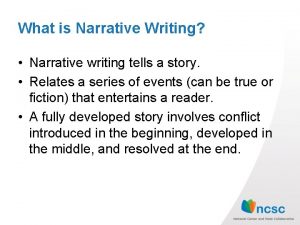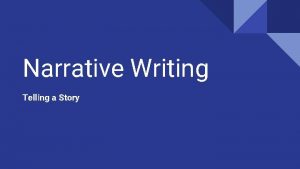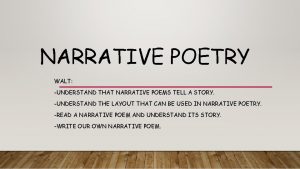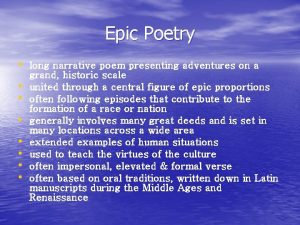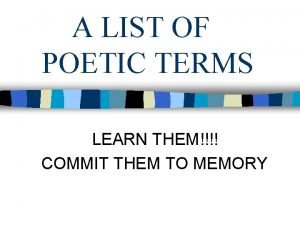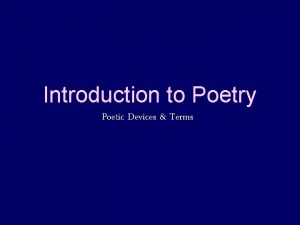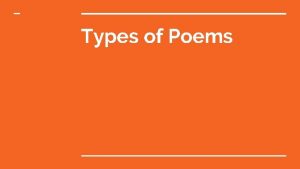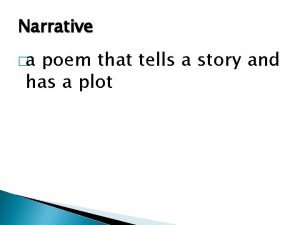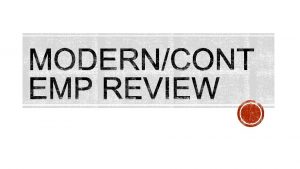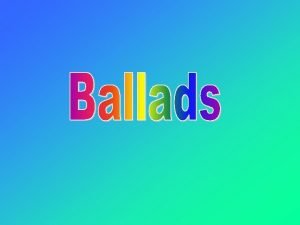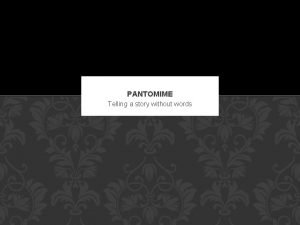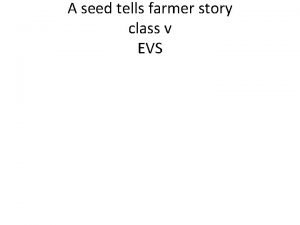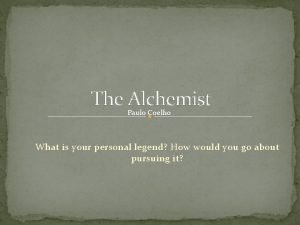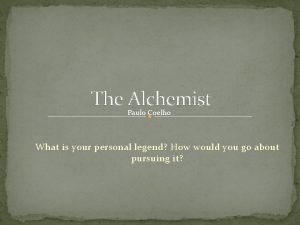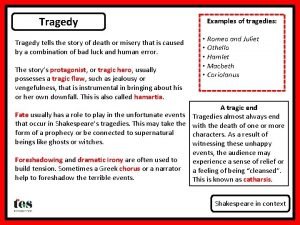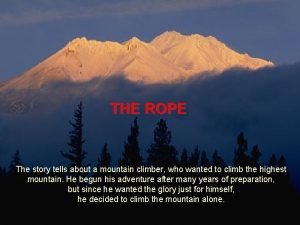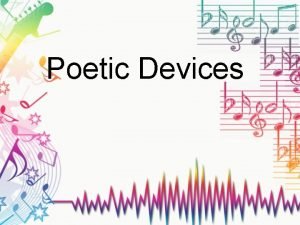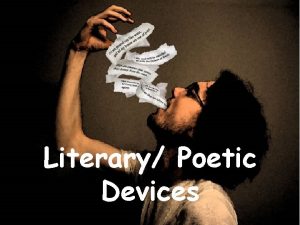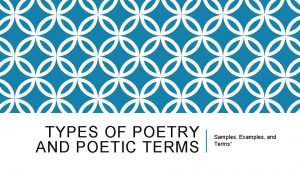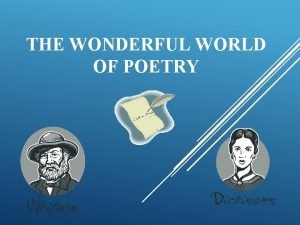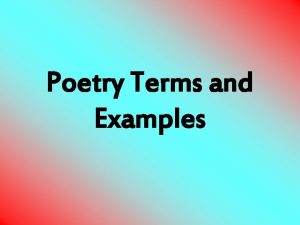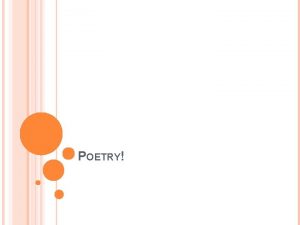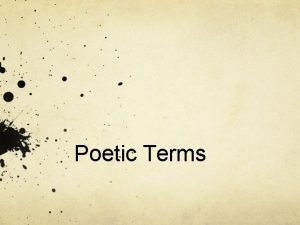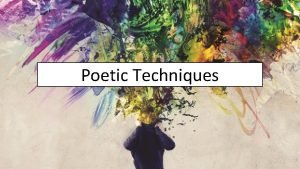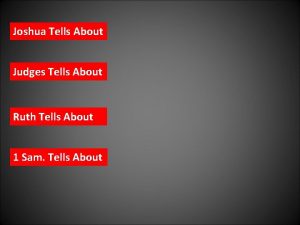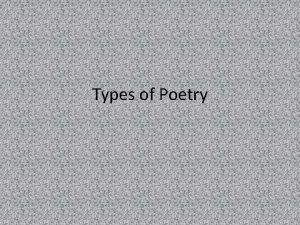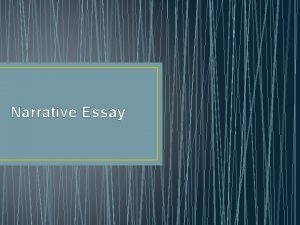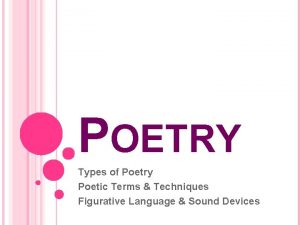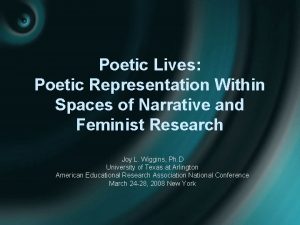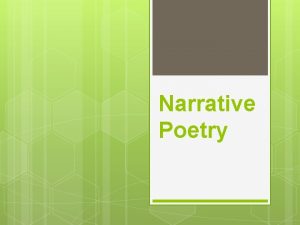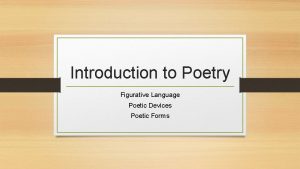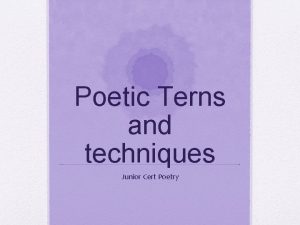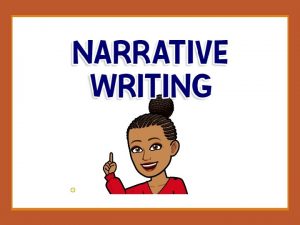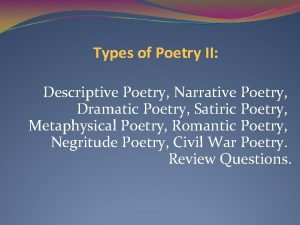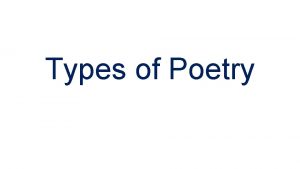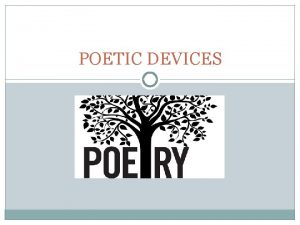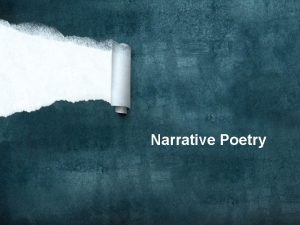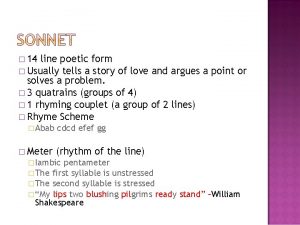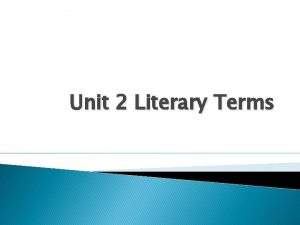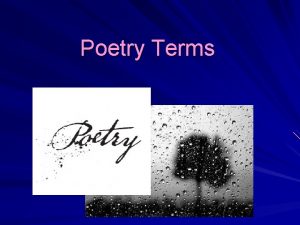Poetic Terms 1 Narrative poetry Tells a story






























- Slides: 30

Poetic Terms

1. Narrative poetry • Tells a story. (any poem which tells a story)

2. Lyric Poem • Any poem which expresses an emotion. (Any poem or song which expresses an emotion and does not tell a story)

3. Free Verse • A poem with no formal rhyme scheme.

4 Rhythm • The varying speed, loudness, pitch, elevation, intensity, and expressiveness of speech, especially poetry. In verse the rhythm is normally regular; in prose it may or may not be regular.

5. Rhyme • Also spelled rime, rhyme is a matching similarity of sounds in two or more words, especially when their accented vowels and all succeeding consonants are identical.

6. End Rhyme Roses are RED, Violets are DEAD When rhyme is on the end of the lines of poetry.

7 Internal Rhyme • Using rhyming words on the same line of poetry • I love dead, red roses.

8 Slant Rhyme • The use of rhyming sounds that are similar but not identical; note that the words do not completely rhyme! • RAVE ROVE • ROT ROCK

9. Alliteration • The repetition of initial consonant sound “The snake slithered slowly”

10. Assonance • May we praise the way? Repetition of vowel sounds

11. Consonance • The use of the same consonant sounds at end of words. Also called slant rhyme or half rhyme (It only rhyme for half the word) • “ Wind wound” “Lake like”

12. Onomatopoeia Words that imitate sounds SNAP CRASH MEOW POP

13. Image • Words or phrases that appeal to senses.

14 Figure of Speech • A deviation from what speakers of a language understand as the ordinary or standard use of words in order to achieve some special meaning or effect. Perhaps the two most common figurative devices are the simile-and the metaphor--a figure of speech in which two unlike objects are implicitly compared without the use of "like" or "as. "

15. Hyperbole An extreme exaggeration. • It is 500 degrees in here • I’ve told you a million times • If I hear that one more time, I will go deaf

16 Metaphor • One thing is compared to another without like or as. • The sky was a blue pool. • The gym was an oven

17 Personification • An animal, idea or object is given human charactersistics. • “Because I could not stop for death, he kindly stopped for me. ” • “The fog crawled” • “The wind spoke”

18 Simile • “The sky is like a big, blue pool”

19 Synaesthesia Mixing the senses: Taking one type of sensory input (sight, sound, smell, touch, taste) and comingling it with another separate sense in an impossible way. In the resulting figure of speech, we end up talking about how a color sounds, or how a smell looks. When we say a musician hits a "blue note" while playing a sad song, we engage in synaesthesia. Other examples: "cool green, " we mix tactile or thermal imagery with visual imagery the same way. When we talk about a "heavy silence, " we also use synaesthesia ; “All I can taste is this moment” “The singing light”

20 Understatement • “War is bad for children” • the opposite of exaggeration: "I was somewhat worried when the psychopath ran toward me with a chainsaw. " (i. e. , I was terrified)

21 Apostrophe • “Oh Superman, where are you now? ” • Not to be confused with the punctuation mark, apostrophe is the act of addressing some abstraction or personification that is not physically present: For instance, John Donne commands, "Oh, Death, be not proud. "

22. Repetition • When a writer repeats words, phrases or ideas

23. Rhetorical question A question without an expected answer. “What did I tell you? • “What are you, a dork? ”

24. Tone • Sad Happy Depressed Vengeful Sarcastic Mocking Bitter

25. Theme • Poems have messages. Themes must be universal and reveal a general truth about life.

26 Synecdoche. • The name of a part is used instead of the name of the whole or vice versa. • “All hands on deck”

27. Metonymy • The naming of an object assoicated with a thing in place of the actual thing itself. • “The pen is mightier than the sword. ”

28. Paradox • “You bleed just to kow your alive” • “The have eyes but see not” • A seemingly contradictory statement; upon further review, the statement reveals a truth has a deeper meaning.

29. Denotation vs 30. Connotation • Denotation is a word’s dictionary definition • Connotation are thoughts, feelings and emotions associated with a word
 Haiku poem
Haiku poem Narrative writing tells a story to
Narrative writing tells a story to Narrative writing tells a story
Narrative writing tells a story Narrative writing tells a story to
Narrative writing tells a story to Literary device
Literary device Features of a narrative poem
Features of a narrative poem Lyric poem template
Lyric poem template A long narrative poem *
A long narrative poem * Poetic terms list
Poetic terms list Poetic diction example
Poetic diction example A song like poem that tells a story
A song like poem that tells a story It is a poem that tells a story
It is a poem that tells a story An intricate dance that tells a story
An intricate dance that tells a story A song transmitted orally which tells a story:
A song transmitted orally which tells a story: What if it finishes class 5 evs ppt
What if it finishes class 5 evs ppt Telling of a story without words
Telling of a story without words A seed tells a farmers story summary
A seed tells a farmers story summary Helvetius elias fulcanelli geber
Helvetius elias fulcanelli geber What is alchemy
What is alchemy What is a tragedy story
What is a tragedy story Sand and stone story
Sand and stone story The story tells about
The story tells about Polynomial degrees and terms
Polynomial degrees and terms What are like terms
What are like terms Introduction to poetry by billy collins
Introduction to poetry by billy collins Poetic devices simile
Poetic devices simile Poetry terms with examples
Poetry terms with examples Poetry terms line
Poetry terms line Poetry terms and examples
Poetry terms and examples Examples of literary techniques
Examples of literary techniques Echo verse examples
Echo verse examples


